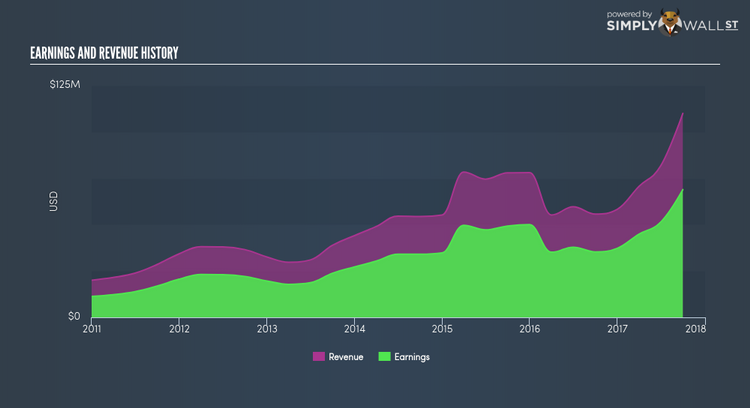Interested In Texas Pacific Land Trust (NYSE:TPL)? Here’s What Its Recent Performance Looks Like

In this article, I will take a look at Texas Pacific Land Trust’s (NYSE:TPL) most recent earnings update (30 September 2017) and compare these latest figures against its performance over the past few years, along with how the rest of TPL’s industry performed. As a long-term investor, I find it useful to analyze the company’s trend over time in order to estimate whether or not the company is able to meet its goals, and eventually grow sustainably over time. See our latest analysis for Texas Pacific Land Trust
Could TPL beat the long-term trend and outperform its industry?
I prefer to use data from the most recent 12 months, which either annualizes the most recent 6-month earnings update, or in some cases, the most recent annual report is already the latest available financial data. This method enables me to examine various companies in a uniform manner using the latest information. “For Texas Pacific Land Trust, its “, latest earnings is $68.9M, which, against the previous year’s level, has moved up by a significant 95.06%. Since these figures are fairly short-term, I have determined an annualized five-year value for Texas Pacific Land Trust’s net income, which stands at $31.8M. This shows that, on average, Texas Pacific Land Trust has been able to gradually improve its profits over the past few years as well.
What’s the driver of this growth? Let’s see if it is merely attributable to an industry uplift, or if Texas Pacific Land Trust has experienced some company-specific growth. In the last couple of years, Texas Pacific Land Trust expanded its bottom line faster than revenue by effectively controlling its costs. This has caused a margin expansion and profitability over time. Viewing growth from a sector-level, the US diversified financial services industry has been growing its average earnings by double-digit 23.27% in the previous twelve months, and 13.50% over the past five years. This means that whatever uplift the industry is gaining from, Texas Pacific Land Trust is able to leverage this to its advantage.
What does this mean?
While past data is useful, it doesn’t tell the whole story. While Texas Pacific Land Trust has a good historical track record with positive growth and profitability, there’s no certainty that this will extrapolate into the future. I suggest you continue to research Texas Pacific Land Trust to get a more holistic view of the stock by looking at:
1. Financial Health: Is TPL’s operations financially sustainable? Balance sheets can be hard to analyze, which is why we’ve done it for you. Check out our financial health checks here.
2. Valuation: What is TPL worth today? Is the stock undervalued, even when its growth outlook is factored into its intrinsic value? The intrinsic value infographic in our free research report helps visualize whether TPL is currently mispriced by the market.
3. Other High-Performing Stocks: Are there other stocks that provide better prospects with proven track records? Explore our free list of these great stocks here.
NB: Figures in this article are calculated using data from the last twelve months, which refer to the 12-month period ending on the last date of the month the financial statement is dated. This may not be consistent with full year annual report figures.
To help readers see pass the short term volatility of the financial market, we aim to bring you a long-term focused research analysis purely driven by fundamental data. Note that our analysis does not factor in the latest price sensitive company announcements.
The author is an independent contributor and at the time of publication had no position in the stocks mentioned.

